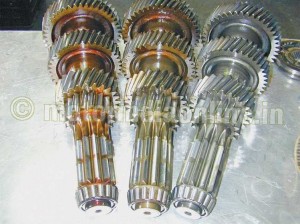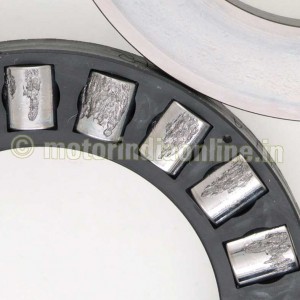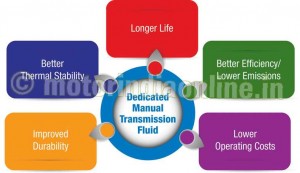Lubrizol, a leading lubricant additive technology and viscosity modifier specialist, highlights how original equipment suppliers,  vehicle manufacturers and fleet owners may benefit from use of dedicated manual transmission fluids (MTFs) in their current and future synchronised manual transmissions.
vehicle manufacturers and fleet owners may benefit from use of dedicated manual transmission fluids (MTFs) in their current and future synchronised manual transmissions.
In an environment of escalating costs, vehicle manufacturers are striving hard to differentiate their products on the lines of reduced ‘cost of vehicle ownership’. Whilst new hardware designs and materials are being developed, lubricant can contribute to improvements in fuel economy and to reduce emissions and maintenance, despite it accounting for only one per cent of the total operating cost of a vehicle in India. Lubrizol’s lubricant technology plays a vital role in attaining these goals.
In line with improved transmission designs and materials, MTFs, the dedicated lubricant technology used in synchronised manual transmissions, have undergone significant technological improvements to deliver enhanced performance even under severe operating conditions. It is therefore easy to conclude that older MTFs will no longer provide optimised transmission solutions. New additive and viscosity modifier technologies have been specifically developed to enable MTFs to address the demands of the new transmissions whilst continuing to offer protection for older transmissions.
The new dedicated MTFs enable improved shift quality, durability, fuel economy and extended drain intervals. These translate directly to increased profitability and return on investment for everyone in the supply chain, from vehicle manufacturers to fleet owners and end users.
 Transmission design changes include selection of different seal and synchromesh materials, increased use of retarders and electronics, more compact designs and incremental improvements in gear geometry and bearing design. These design changes are driven to address the changing and more challenging operating conditions. Modern vehicles have higher horsepower engines and are driven at significantly higher speeds. They are hauling much heavier loads. All this at a time when the hardware and oil sump size is reducing in order to gain efficiency. As such these influence the choice of additive and viscosity modifier technology selected for the MTF.
Transmission design changes include selection of different seal and synchromesh materials, increased use of retarders and electronics, more compact designs and incremental improvements in gear geometry and bearing design. These design changes are driven to address the changing and more challenging operating conditions. Modern vehicles have higher horsepower engines and are driven at significantly higher speeds. They are hauling much heavier loads. All this at a time when the hardware and oil sump size is reducing in order to gain efficiency. As such these influence the choice of additive and viscosity modifier technology selected for the MTF.
Historically a variety of synchronizer materials have been used in manual transmissions, primarily brass for smaller vehicles such as passenger cars and molybdenum-based products for larger commercial vehicles. Now sinter compositions and more recently carbon synchronizers are being employed. Phenolic materials are also used in Japan. Each composition affords the designer different wear and durability properties.
From the lubricant perspective these materials exhibit different frictional properties which will impact gear shift quality, thereby  demanding revision to the MTFs’ frictional properties to ensure optimum performance with the selected synchronizer material.
demanding revision to the MTFs’ frictional properties to ensure optimum performance with the selected synchronizer material.
Aerodynamic styling and noise legislation have reduced airflow over transmission, and this, together with increased use of retarders, results in higher transmission operating temperatures, thereby demanding increased thermal durability from the MTF. Additive technology addresses this performance, thus preventing formation of acidic by products of oxidation which can lead to corrosion as well as formation of varnish and sludge onto critical components, thus reducing optimum performance and efficiency.
Government legislation in many developed countries requires continuous fuel economy improvements. In India there is already a talk on introducing a legislation for rating of passenger cars based on the fuel economy. The increased pressure for fuel economy improvements has initiated more compact transmission designs, component weight reductions and the move toward lower viscosity MTFs. In mature markets of Europe and North America, the trend is towards SAE 75W and SAE 75W-80 viscosity grades. In emerging markets like India and China, the trend is towards SAE 75W-90 viscosity grades, moving away from SAE 80W-90 grades, and further lower viscosity grades are also being considered.
Compact designs, weight reductions and a thinner film thickness at the gear interface, resulting from the newly-selected viscosity grades, place greater emphasis on the MTF’s load carrying capacity and pitting resistance. A robust and effective additive and viscosity modifier technology is therefore critical to provide improved protection of gears and bearings.
 The market is also witnessing a broader range of base oils being used to formulate MTFs. These range from Group l through to synthetic solutions, with alternatives in between, including Group ll and lll base oils. The base oil type impacts the choice of additive and viscosity modifier technology to support them.
The market is also witnessing a broader range of base oils being used to formulate MTFs. These range from Group l through to synthetic solutions, with alternatives in between, including Group ll and lll base oils. The base oil type impacts the choice of additive and viscosity modifier technology to support them.
Further there is a steady drive to increase oil drain intervals, thus reducing maintenance costs. In India, some passenger cars already have fill-for-life MTFs, i.e., no oil change during the life of transmission. This trend is likely to continue as the competitive market extends vehicle warranties. As a result, the MTF is in a more hostile environment for longer periods of time, and therefore retention of additive performance over these extended time periods is essential.
Simon Evans, Regional Business Manager, Driveline, comments: “Today’s dedicated manual transmission fluids are engineered to smoothly marry and provide optimum compatibility with newly designed hardware and materials, i.e., provide good, friction behaviour with variety of synchronizer material, have optimum performance under harsher operating conditions of high temperatures and loads, i.e., higher gear and bearing protection, and sustain their performance over longer operating periods. This in effect translates to improved gear shift comfort, reduced downtime, maintenance cost, fluid change-over and improved fuel economy.”
The above factors highlight the importance of using a dedicated MTF as part of the holistic solution in an optimised synchronised manual transmission. Improved gear shifting characteristics, reduced maintenance costs and potential for fuel savings are factors that benefit vehicle drivers and fleet owners when selecting a dedicated MTF solution. End users who have improper fluids in their vehicles may have a wrong impression of running their vehicles at low cost due to use of inexpensive market-general fluids, but actually they would have high ‘cost of ownership’ as general fluids would have high probability of performance leading to vehicle breakdown, subsequent repair and vehicle downtime contributing heavily to their operating costs.
Thus selecting a low-cost MTF in place of a dedicated MTF containing robust additive and viscosity modifier technology is false economy, reducing the opportunity for optimized transmission solutions with associated savings.